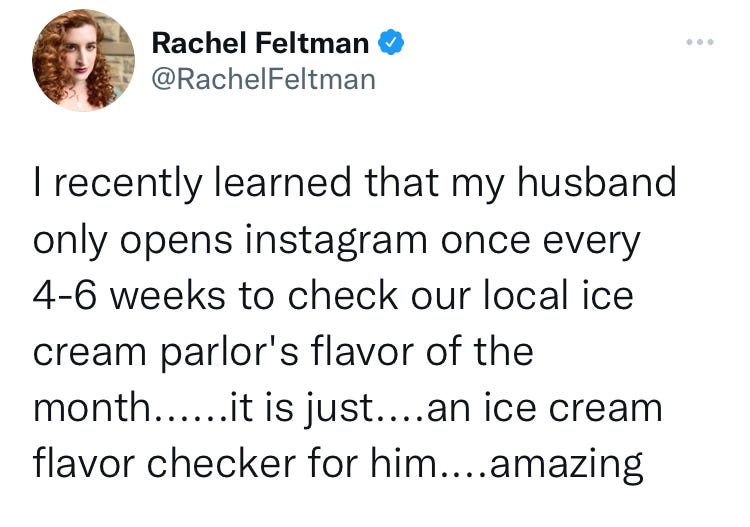Going full screen

Just Another Day in Social Media. 😉
If you heard a collective cheer go up about a week ago, that was just social media managers celebrating the fact that you can now post TikTok content from third-party social media management tools. Of course, this may mean that some social media managers who aren't on TikTok yet might feel pressure to add it to their strategy. And since TikTok is more resource intensive than other platforms, that might mean more work. But hey, at least Ontario now has a "right to disconnect" law, so that work-life boundary should be pretty clear, right? 😳
Here are today's top stories:
Instagram's full-screen Home Feed has some pros and cons
How to... split test organic Facebook content
And a pretty good reason to use Instagram
Read on ⬇️

Insta-change
We're all still "doing it for the Gram," but in the future, that might look a little bit different. That's because the company has started testing a new full-screen Home Feed that favours video, while also making longer captions much harder to read. And like all big changes, there are pros and cons — and many of these will affect your Instagram strategy. Here's what you need to know...
How it started:
Instagram launched in October 2010 with the goal of making it easier to upload photos, make them beautiful, and share them on multiple platforms. And for more than a decade, we all understood what was expected of us on this platform — share beautiful photos of our best lives. But then in August 2020, Instagram Reels launched, infusing TikTok-style video content to the platform. Ok, we all thought, that might be doable (even though we were already posting to the grid, Stories, and sometimes even IGTV 🙄). And then last June, in an even bigger shift — Instagram CEO Adam Mosseri announced that Instagram was no longer a photo-sharing app. It wants to be an entertainment app, with a focus on video and creator content, he said. Enter the full-screen Home Feed...
Old vs. New
CAPTIONS: In the new full-screen mode, you only see a few words of the first sentence and then you have to hit "more" vs. a few sentences in the OG screen mode. Also, scrolling to read the caption is really awkward in FS mode, because the caption is maintained in a really small area at the bottom of the image vs. clicking "more" and having the caption pop open below the image on a white background. With this new caption experience, less appears to be better than more.
CONTENT: Perhaps I'm just used to TikTok's full-screen mode (which only features videos), but it feels like Instagram's viewing experience also tends to favour video content. Whenever I land on a pic vs. a video, the content looks stagnant and almost like a "mistake." But this may be no "mistake" on Instagram's part because they've been trying to get all of us to use Reels for a while now (you can even reply to comments with a Reel now). So if you aren't used to regularly creating video content, I suggest starting now!
OTHER CHANGES:
For post date, there is no longer a calendar date (for example, June 6); instead the post only says how many days/weeks ago the post was created.
For photos, there is a border of colour that appears around photos that match a main colour in the image.
THE BEST PART OF THE UPDATE
Like counts — There aren't any! When viewing other people's posts, it just says "View Likes." And when you click through, you can see who liked the post, but not how many people did. This is amazing because like counts have been shown to impact mental health and personal well being (we should never measure our worth in likes). What is quantified: how many comments have been made on a post, and video plays (account owners can see all data on their own posts).
WHAT DOES IT LOOK LIKE? Scroll down for a screen grab of a photo from full-screen Home Feed.
How it's going:
No one really likes change, and this is a BIG one. Instagram is basically a completely different app from the one that first launched on October 6, 2010.
And for creators, this adjustment is going to be a lot harder for some than others. For example, photographers will obviously have a harder time turning photos into videos (and may want to look to TikTok for examples of how creators manage this on that platform). Some creators have actually taken the time to outline some key issues, such as photographer Johan Lolos (@LeBackpacker) who listed his feedback in a Twitter thread.
Ultimately, if this test rolls out more widely and becomes permanent, social media managers will be forced to turn the volume ⬆️ on video content and turn the volume ⬇️ on text captions — at least that's what I'm preparing my clients for. You may also need to reconfigure your strategy for the types of content you share on the grid vs. Stories vs. Reels.
I'd love to hear your thoughts!

Managing social media is hard enough — staying up-to-date shouldn't be. Level up your social media knowledge in minutes a week. Sign up for our newsletter today!
ICYMI
🔴 Instagram launches new templates and stickers for Reels [Instagram Blog]
🔴 Meta tests digital collectibles to share NFTs on Instagram [Meta Blog]
🔴 Twitter introduces a crisis misinformation policy [Twitter Blog]
🔴 Snapchat's shared Stories will let you collaborate with friends of friends [Engadget]
🔴 LinkedIn creates a "Mythbusting the Feed" series of blog posts and on-platform content [LinkedIn Blog]
HOW TO...
There are so many amazing social media experts out there, and the one that I turn to for Facebook support is Jon Loomer. I highly recommend signing up for his emails, where you'll not only get info about Facebook advertising, but also tidbits like this: 2 Ways to Create A/B Split Tests of Organic Content on Facebook.
I am in no way affiliated with Jon Loomer, and honestly didn't know you could split test organic FB content!
DO ME A FLAVOUR
A Good a Reason as Any to Use Instagram

Hey, congrats — you made it to the bottom of the e-newsletter!
If you really liked it, why not forward it to a friend. 💌


